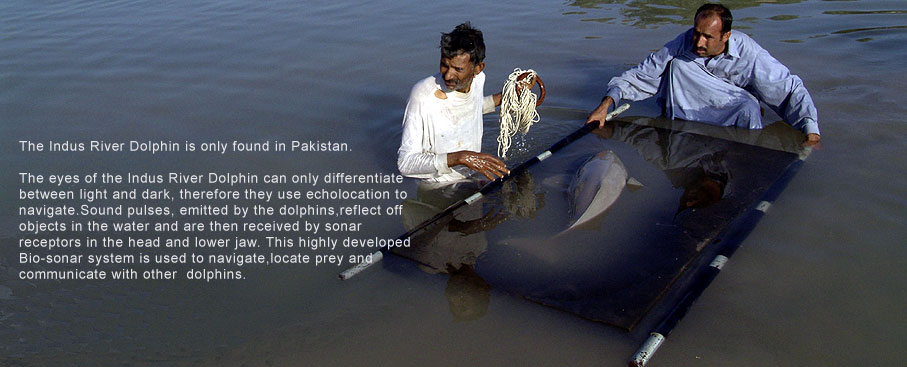Species
 The Indus River Dolphin (Platanista minor)
The Indus River Dolphin (Platanista minor)
The Indus River dolphin (Platanista minor) is one of the world's rarest mammals and the second most endangered freshwater river dolphin. Approximately 1,100 specimens of this species exist today in a small fraction of their former range, the lower reaches of the Indus River in Pakistan.
However, the population of this species has gradually declined because of various factors, including water pollution, poaching, fragmentation of habitat due to barrages, and dolphin strandings in the irrigation canals.
Numbers have dramatically declined since the construction of the irrigation system in the Indus. Most individuals now remain in a 1,200 km stretch of the Indus River.
In addition to efforts to conserve their habitat, including addressing problems such as river pollution, WWF staff have also been involved in rescue missions when individual dolphins become trapped in canals. WWF also coordinated the largest survey of the species ever in 2001 in collaboration with partners.
WWF-Pakistan assists in a numberof education initiatives and has arranged training courses for various institutions. An aerial survey of the species range was conducted in 2003.
WWF's objective for freshwater cetaceans is to ensure that habitat degradation, strandings and fisheries bycatch do not threaten freshwater cetaceans.
 What we are doing What we are doing
Indus River Dolphin Conservation Project (IRDCP)
WWF - P developed this project to conserve the viable population of Indus River Dolphin by protecting the innate biodiversity of the lower Indus river basin Eco-system, and reducing the losses of Indus river dolphins by canal stranding through rescue operations.more
 WWF - Pakistan, as part of its Indus Dolphin Conservation Initiatives, is improving agricultural practices near the dolphin habitat to reduce the agrochemical pollution in the Indus River. The main partners in this activity are CAB International Regional Bioscience Centre Pakistan (CABI RBC PAK) and Agriculture Extension Department Sindh. This picture shows an activity where the expert facilitator is with farmer participants checking the progress of cotton in a demonstration plot, where lesser water and agrochemical were used. This is a part of the skill enhancement training session. WWF - Pakistan, as part of its Indus Dolphin Conservation Initiatives, is improving agricultural practices near the dolphin habitat to reduce the agrochemical pollution in the Indus River. The main partners in this activity are CAB International Regional Bioscience Centre Pakistan (CABI RBC PAK) and Agriculture Extension Department Sindh. This picture shows an activity where the expert facilitator is with farmer participants checking the progress of cotton in a demonstration plot, where lesser water and agrochemical were used. This is a part of the skill enhancement training session.
 The participants of the Skill Enhancement Training Session of Facilitator (SETSF) are engaged in transplanting of rice in a demonstration plot, where Better Management Practices are shown such as use of less agrochemicals and water. Through such sessions, farmers learn that excessive use of water and agrochemical is not equivalent to more yield. The participants of the Skill Enhancement Training Session of Facilitator (SETSF) are engaged in transplanting of rice in a demonstration plot, where Better Management Practices are shown such as use of less agrochemicals and water. Through such sessions, farmers learn that excessive use of water and agrochemical is not equivalent to more yield.
|
Physical Description
Species Description
The species is characterized by a long beak, rounded belly, stocky body, very small dorsal fin and large flippers. Although its eye hasn't developed a lens (this species is also referred to as the "blind dolphin"), the dolphin still uses its eyes to differentiate between light and dark. It relies on echolocation (sound sensors) to find fish, shrimp, and other prey in the bottom mud.
The Indus River dolphin swims on its side, at times enabling it to move in water as shallow as 30 cm. As it swims on its side, it trails a flipper along the bottom of the river. After 30 to 60 seconds, when it needs to breath, it swims to the surface, rotates upright to take in the air, and then rotates 90 degrees again as it swims back to the bottom. This unique side swimming behaviour is not consistently seen in any other dolphin, except the Ganges River dolphin.
The Indus River dolphin migrates upstream into the smaller tributaries during the monsoon rains and migrates downstream to the main channels in the dry season.
Size
The Indus River dolphin weighs 70-110 kg (155-245 lbs). The maximum size is 2.5m (8.2 ft), with males smaller than females.
Habitat
Biogeographic realm
Indo-Malayan
Range States
Pakistan
Ecological Region
Indus river Delta & Rann of Kutch
Endemism
Indus river system of Pakistan
Interesting Facts
The Indus River dolphin sometimes carries its young on its back, above the surface of the water. |
|
Common Name
Indus River dolphin, bhulan, blind river dolphin, Indus dolphin, side swimming dolphin;
Plataniste de l'Indus (Fr);
Delfín del Indo (Sp)
Scientific Name
Platanista minor
Status
IUCN : Endangered (EN A1acd, B1+2abcde
Population
Approximately 1,300 |
 Hey kids! Want to learn while having fun? Hey kids! Want to learn while having fun?
Just click on the picture to download a booklet of our cute Indus Dolphin:
|
| |
| |
|
| |
|
 The Indus River Dolphin (Platanista minor)
The Indus River Dolphin (Platanista minor)
 WWF - Pakistan, as part of its Indus Dolphin Conservation Initiatives, is improving agricultural practices near the dolphin habitat to reduce the agrochemical pollution in the Indus River. The main partners in this activity are CAB International Regional Bioscience Centre Pakistan (CABI RBC PAK) and Agriculture Extension Department Sindh. This picture shows an activity where the expert facilitator is with farmer participants checking the progress of cotton in a demonstration plot, where lesser water and agrochemical were used. This is a part of the skill enhancement training session.
WWF - Pakistan, as part of its Indus Dolphin Conservation Initiatives, is improving agricultural practices near the dolphin habitat to reduce the agrochemical pollution in the Indus River. The main partners in this activity are CAB International Regional Bioscience Centre Pakistan (CABI RBC PAK) and Agriculture Extension Department Sindh. This picture shows an activity where the expert facilitator is with farmer participants checking the progress of cotton in a demonstration plot, where lesser water and agrochemical were used. This is a part of the skill enhancement training session.  The participants of the Skill Enhancement Training Session of Facilitator (SETSF) are engaged in transplanting of rice in a demonstration plot, where Better Management Practices are shown such as use of less agrochemicals and water. Through such sessions, farmers learn that excessive use of water and agrochemical is not equivalent to more yield.
The participants of the Skill Enhancement Training Session of Facilitator (SETSF) are engaged in transplanting of rice in a demonstration plot, where Better Management Practices are shown such as use of less agrochemicals and water. Through such sessions, farmers learn that excessive use of water and agrochemical is not equivalent to more yield.  Hey kids! Want to learn while having fun?
Hey kids! Want to learn while having fun?